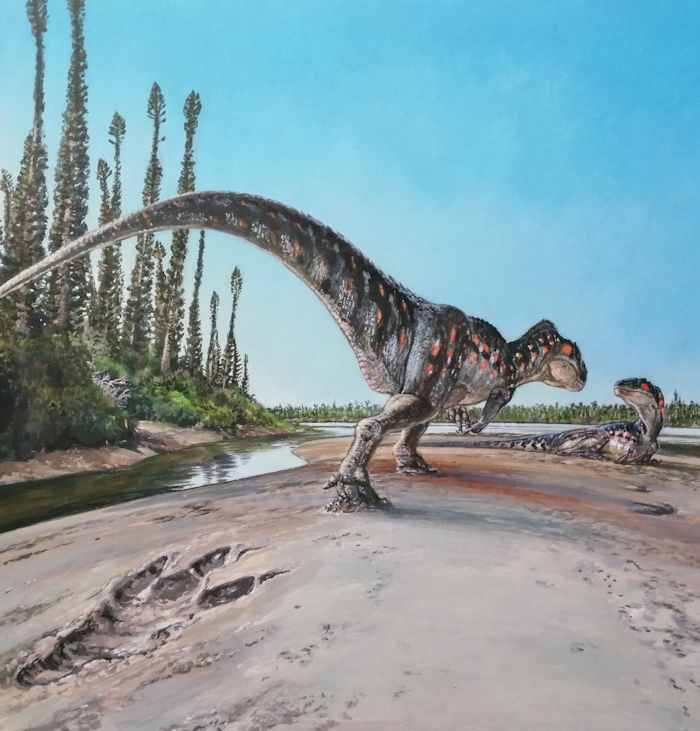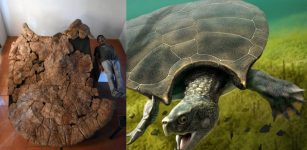Giant Meat-Eating Dinosaur Footprint Found In Yorkshire Could Be The Largest Ever
Eddie Gonzales Jr. – MessageToEagle.com – An almost meter-long footprint made by a giant, a meat-eating theropod dinosaur from the Jurassic Period represents the largest of its kind ever found in Yorkshire.
Curiously, the unusual footprint appears to capture the moment the dinosaur rested or crouched down some 166 million years ago.
Giant dinosaur footprint found in Yorkshire. Credit: Marie Woods
The Yorkshire coast is renowned for producing some visually and scientifically incredible fossils, including thousands of dinosaur footprints. A popular destination for professional paleontologists and fossil fans, people come from far and wide to see what they can find; however, it is not every day that a footprint measuring 80 centimeters in length is discovered.
This record-breaking print was found by local archaeologist Marie Woods in April 2021. She had gone out along the coast and found this amazing fossil completely by chance. In her excitement and disbelief, Marie made contact with local fossil experts, but none were aware of the track she was describing. Following this, she then contacted Dr. Dean Lomax, a paleontologist affiliated with The University of Manchester and author of “Dinosaurs of the British Isles.”
Marie, who is now a co-author of the study, said, “I couldn’t believe what I was looking at, I had to do a double take. I have seen a few smaller prints when out with friends, but nothing like this. I can no longer say that ‘archaeologists don’t do dinosaurs.’ At the time of the discovery, it generated a lot of public interest and I was overwhelmed with the messages on social media from people around the globe.”
This latest, scientifically significant footprint to be found along the Yorkshire Coast is one of only six similar prints to have been recorded in the area, the first being found in 1934. The tridactyl (three toed) print is the largest on record. The previous print, on display in the Rotunda Museum, Scarborough, was discovered in 2006, by John Hudson, the lead author of the new study describing the giant find.
Local geologist and lead researcher, John Hudson, said, “This important discovery adds further evidence that meat-eating giants once roamed this area during the Jurassic. The type of footprint, combined with its age, suggests that it was made by a ferocious Megalosaurus-like dinosaur, with a possible hip height between 2.5 and 3 meters.” Megalosaurus was the first dinosaur to be formally described, in 1824.
After numerous conversations and the exchange of images, which showed extensive fragility, it was clear that immediate action was required to recover the important specimen from the shoreline. Leaving it would see it exposed to further erosion and damage from the tide or complete loss through landslips.
Working together, the team had to move quickly and arranged for the specimen to be safely and responsibly collected. The specimen was expertly recovered by experienced fossil collectors, Mark, Aaron and Shae Smith of Redcar.
As the rescue mission went underway, it came to light that the track had actually been spotted five months earlier, by local fossil hunter and co-author of the new study, Rob Taylor. However, at the time of initial discovery the track was not fully exposed, and therefore the full extent and importance of the footprint had not been fully realized.
A co-author of the new study, Dr. Lomax said, “We’re incredibly grateful to Mark, Aaron and Shae for rescuing this important specimen and ensuring that it was saved for science. Now that the specimen has been studied, plans are in motion for it to go on public display, to spark the imagination of the next generation of fossil hunters.”
Marie and Rob donated the specimen to Scarborough Museum and Galleries. It has now been examined by both John Hudson and Dr. Dean Lomax, with additional input from Dr. Mike Romano from the University of Sheffield. Dr. Romano has conducted over 20 years of research on the Yorkshire Coast, especially collecting and studying hundreds of dinosaur tracks. The team compared the new specimen with similar tracks collected from across the globe, especially in Europe and North America.
“The east coast of Yorkshire is known as the Dinosaur Coast for very good reasons,” said Dr. Romano. A huge number of dinosaur tracks, ranging in the thousands, have been discovered. As a result, this stretch of coastline is considered one of the best places in the world for dinosaur footprints. Although first documented way back in 1907, it was not until the 1980s that finds were being reported on a regular basis (by amateurs as well as professional geologists), until today approximately 25 different types of footprints have been recognized.
Dr. Romano added, “Although these different types do not necessarily represent the same number of different dinosaurs, they do indicate a diverse ecosystem of animals including both carnivores and herbivores that roamed the Jurassic coastal plain and fluvial complex some 160-175 million years ago. The prints also allow us to interpret their behavior. Thus, we have records of walking, running and swimming dinosaurs.”
Footprint maker. Credit: James McKay
Dr. Lomax added: “This is a wonderful find. Not only does this specimen represent the largest theropod footprint found in Yorkshire, but by studying the angle of the footprint, its shape, and the impressions of the claws, the fossil provides insights into the behavior of this individual from around 166 million years ago. In fact, features of the footprint may even suggest that this large predator was squatting down before standing up. It’s fun to think this dinosaur might well have been strolling along a muddy coastal plain one lazy Sunday afternoon in the Jurassic.”
Dr. Lomax is also the author of “Locked in Time”, a book which focuses on exceptional evidence of prehistoric animal behavior.
The footprint, which is now in the guardianship of Scarborough Museum and Galleries, will hopefully go on public display with the Rotunda Museum’s other fossil footprints, once conservation has been completed.
The new study is published in the Proceedings of the Yorkshire Geological Society.
Written by Eddie Gonzales Jr. – MessageToEagle.com Staff












